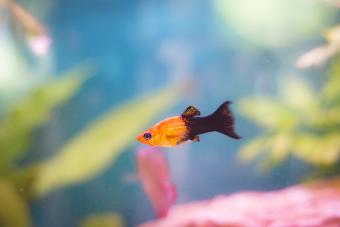
The betta bubble nest is a display of parental care. In most cases, the male betta constructs a bubble nest for the eggs out of mucus, air, and plant matter. With this in mind, the male Siamese Fighting Fish or betta splendens is the best-known anabantoid species and nest builder among hobbyists.
Betta Bubble Nest
Fish display a wide range of egg-laying behaviors. The anabantoid species includes all betta fish, and the male builds nests out of saliva to create mucus bubbles. This nest and plant material hold the eggs and ultimately the fish.
The Labyrinth Organ
This unique structure near the gills of anabantoids enables the fish to breathe atmospheric air directly. Male bettas don't just use this organ for breathing but for building too. The betta fish also use mucus and air to prevent the bubble nest from popping and breaking apart.
Males Construct Bubble Nests
Spawning occurs near the nest, and the female floats upside down while the male collects the eggs in its mouth and swims to the bubble nest. It is best to remove the female betta while the male guards the nest. The fish keeper may decide to keep the female in the tank if it is large.

Betta Bubble Nest Behavior
The males guard the nest and the fry (recently hatched fish). Male bettas may drive the females away after spawning and watch the nest alone.
Betta Blowing Bubbles
Other anabantoids exhibit bubble-nesting behavior. Bettas are not the only fish blowing bubbles. Some smaller fish prefer to make bubble nests in underwater caves.
- Pearl Gouramis
- Hoplos catfish
- Paradise Fish
- Giant Gourami
The Best Bubble Nest Fish
The popular Siamese Fighting Fish wins the title of best-known bubble nester. There are many notable features about this fish breed and reasons it is the best-known anabantoid fish among hobbyists. Betta splendens are known for beautiful color variations with 100 strains available.
- A Siamese Fighting Fish needs space, and small jars are not appropriate.
- A single male may live with several females in a tank or a community tank.
- Betta splendens are easy to care for but don't live very long.
- These fish are not always ready for a fight, and actual conflict is the last resort.
- Male bettas raise the fins and flare the gill to appear larger than life.
Bubble Nests Vary in Size
The size of a bubble nest may vary, and the fish species dictates the diameter and overall height. Giant Gourami bubble nests measure up to 20 inches in diameter and 10 inches in height.
Egg-Layers Versus Livebearers
Egg-layers practice external fertilization, and livebearers practice internal fertilization. As far as reproductive behavior, most fish fall into the egg-laying category.
Other Egg-Laying Behaviors
Fish display a range of egg-laying behavior beyond bubble nests. Some bettas are mouth-brooding, and the species with this egg-laying behavior is known for its sizeable oral cavity.
- Egg-scattering: The female releases a large number of eggs at random.
- Egg-depositing: A pair carefully picks the site where they can lay eggs.
- Egg-burying: Species dwell in muddy pools, and the eggs lie dormant in dry mud and hatch.
- Mouth-brooding: The parent fish take the eggs in its mouth and hold them there until they hatch.
Male Bettas Win Parent of the Year Award
It is clear why little jars are not appropriate for this fish species. Male bettas construct beautiful bubble nests from saliva and need space at the surface of the tank. All anabantoid species share this egg-laying behavior, but the Siamese Fighting Fish is the best-known bubble nest fish. There is no reason for concern when a nest appears at the surface. Blowing bubbles is perfectly normal behavior for bettas.







